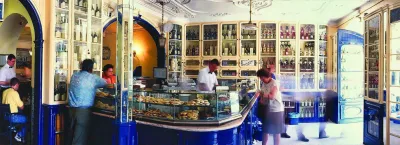
Pastel de nata
The best treat in town served in a beautiful cacophony of blue and white decor, is how you might describe this place. Located in the (well worth a visit) riverside suburb of Belém , the Antiga Confeitaria de Belém is the mecca of the Portuguese custard tart lover.
The tart itself (named a pastel de nata) combines a perfectly crunchy pastry shell with an egg custard filling that is neither too sweet, nor too eggy and just the right side of firm. Finer you will struggle to find, and perhaps this is due to the top-secret recipe that has been passed down from master confectioner to his successor since the bakery’s inception in 1837. Indeed the ingredients are mixed behind closed doors to this day!
The story goes that the liberal revolution of 1820 is largely to blame for these cakes as it brought about the closure of the nation’s monasteries and convents in 1834. The recipe is believed to have originated from the Jerónimos Monastery next door, arriving at the then small shop with attached sugar refinery with an expelled monk.

Interestingly, at that time great quantities of egg white were used for starching in monasteries and convent for starching habits. As a result, it was common for these places to use the unused yolks in the production of sweets. Belém, already popular with day-trippers from the city and beyond because of aforementioned beautiful monastery, riverside walks and the ornate and historical tower, soon gained a reputation for these pastries.
Served fresh from the oven, you can take the pastéis away in attractive hexagonal tubes or eat them in the cavernous café with a coffee, where they are served with cinnamon (canela) and icing sugar to dust on according to personal taste.
The café itself is also interesting. The front portion still houses beautiful glazed floor- to-ceiling cabinets containing bottles of traditional Portuguese liqueurs and period china. Beyond you will find room after room of walls tiled in the traditional small Portuguese blue and white azulejos, decorated with animals, plants, ships and houses amongst other things. Keep going until you find a free table and enjoy.